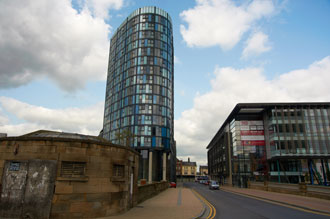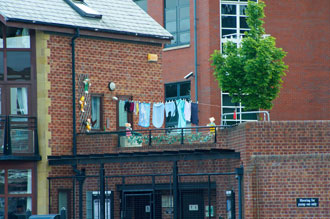Tokina ATX AF 16.5-135mm f/3.5-5.6
Tokina ATX AF 16.5-135mm f/3.5-5.6: Performance
Shooting wide open at 16.5mm, this lens already produces very good sharpness in the centre of the frame, and the quality towards the edges is fairly good. Stopping the lens down improves sharpness and peak quality across the frame is achieved at f/8, where the sharpness in the centre is outstanding, and the quality towards the edges approaches excellent levels.Zooming to 50mm results in a drop in quality at maximum aperture, with results being fairly good in the centre and fair towards the edges. Stopping down dramatically improves the quality though and by f/8 sharpness is excellent across the frame.
Finally at 135mm the sharpness at maximum aperture in the centre of the frame is fair, but the quality towards the edges is sub-par. The lens really benefits from being closed down a stop and by f/11 the sharpness in the centre is excellent, and good towards the edges.
| Resolution at 16.5mm | Resolution at 50mm | |
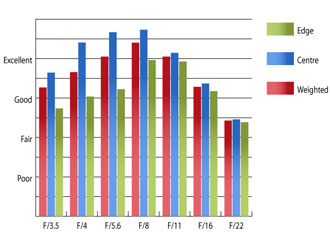 | 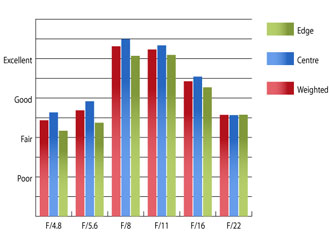 | |
| Resolution at 135mm | How to read our graphsThe blue column represents readings from the centre of the picture frame at the various apertures and the green is from the edges. Averaging them out gives the red weighted column.The scale on the left side is an indication of actual image resolution. The taller the column, the better the lens performance. Simple. For this review, the lens was tested on an Nikon D300 using Imatest. | |
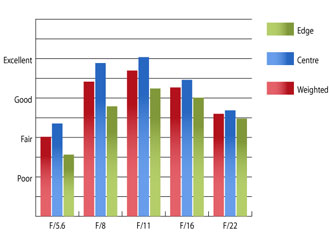 |
At the wider end of the zoom range, chromatic aberrations are well enough controlled to pose few issues, even in large prints, or harsh crops from the edge of the frame. However at 135mm it is a different story altogether, with fringing exceeding two pixel widths near the edges of the frame at every aperture.
| Chromatic Aberrations at 16.5mm | Chromatic Aberrations at 50mm | |
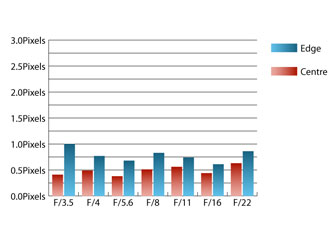 | 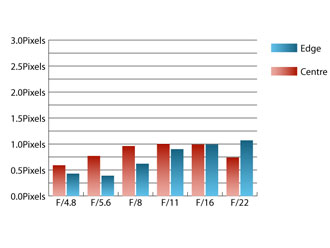 | |
| Chromatic Aberrations at 135mm | How to read our chartsChromatic aberration is the lens' inability to focus on the sensor or film all colours of visible light at the same point. Severe chromatic aberration gives a noticeable fringing or a halo effect around sharp edges within the picture. It can be cured in software.Apochromatic lenses have special lens elements (aspheric, extra-low dispersion etc) to minimize the problem, hence they usually cost more. For this review, the lens was tested on an Nikon D300 using Imatest. | |
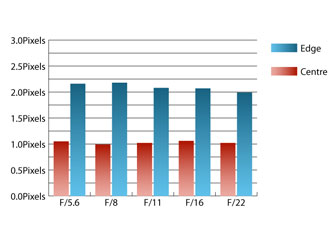 |
Falloff of illumination towards the corners is kept to acceptable levels at the wide end, with the corners only being 1.3stops darker than the centre at f/3.5. Visually uniform illumination is achieved by f/5.6 at this focal length. At the telephoto end of the range, falloff is even less noticeable. Here the corners are only 0.6stops darker than the image centre and visually uniform illumination is achieved by f/7.1.
As is typical for high zoom ratio lenses, barrel distortion is quite strong at the wide end of the range at 6.15%. At the telephoto setting, this barrel distortion is traded for very mild pincushion distortion. Here Imatest detected 0.5% pincushion distortion which will be very hard to spot in normal images. The distortion pattern at each end of the zoom is uniform across the frame, and so should be easy enough to correct in image editing software afterwards.
A deep petal shaped hood is supplied with this lens, which does an excellent job of shielding the front element from extraneous light that may cause flare or loss of contrast. When shooting directly into strong light sources, contrast can suffer, especially at the telephoto end of the range, but under normal conditions the lens is quite resistant to flare.
Add your message
Login required
Please login here or if you've not registered, you can register here. Registering is safe, quick and free.
Please login here or if you've not registered, you can register here. Registering is safe, quick and free.
photodo Stats
1102 lenses
428 MTF tests
74 in-depth photodo reviews
100+ users join each day
Help the lens community by reviewing or rating a lens today via our lens search
428 MTF tests
74 in-depth photodo reviews
100+ users join each day
Help the lens community by reviewing or rating a lens today via our lens search
Latest Lens Reviews
- Chinon 28mm f/2.8 Vintage Lens Review
- Canon EF 70-200mm f/4L IS II USM Lens Review
- Samyang AF 85mm f/1.4 EF Review
- Sigma 70mm f/2.8 DG Macro Art Review
- Samyang AF 24mm f/2.8 FE Review
- Meike 50mm f/1.7 Review
- Tamron 70-210mm f/4 Di VC USD Review
- Lensbaby Burnside 35mm f/2.8 Review
- Asahi Super Takumar 50mm f/1.4 Review
- Asahi Super-Multi-Coated Takumar 135mm f/3.5 Review
